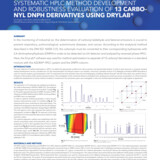
In the monitoring of industrial air, the determination of carbonyl (aldehyde and ketone) emissions is crucial to prevent respiratory, pulmonological, autoimmune diseases, and cancer. According to the analytical method described in the DIN ISO 16000-3 standard [1], the carbonyls must be converted to their corresponding hydrazones with 2,4-dinitrophenylhydrazin (DNPH) in order to be detected via UV detector and analyzed by reversed phase HPLC. Here, the DryLab® software was used for method optimization to separate of 13 carbonyl derivatives in a standard mixture with the AZURA® HPLC system and the DNPH-column.

MODR Method Operation Design Region

Fig. 3: Optimized chromatogram, performed under selected conditionshod with the DNPH column
| Method | HPLC |
|---|---|
| Mode | RP |
| Substances | Acetaldehyde-DNPH, Acetone-DNPH, Acroleine-DNPH, Benzaldehyde-DNPH, 2-Butanone-DNPH, n-Butyraldehyd-DNPH, Crotonaldehyde-DNPH, Formaldehyde-DNPH, Hexaldehyde-DNPH, Methacroleine-DNPH, Propio |
| Key words | Aldehyde- and Ketone-DNPH, DryLab, method optimization, UHPLC |
| CAS number | 1019-57-, 1567-89-1, 888-54-0, 1157-84-2, 958-60-1, 1527-98-6,1527-96-4, 1081-15-8, 1527-97-5, 5077-73-6, 725-00-8, 2880-5-9, 2057-84-3 |

We are happy to help you